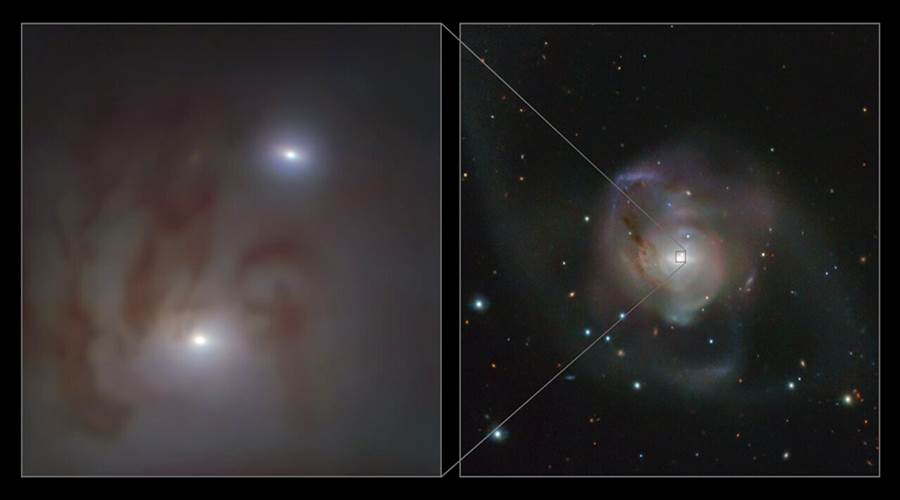Wed 01 December 2021:
Using the European Southern Observatory’s Very Large Telescope (ESO’s VLT), astronomers have revealed the closest pair of supermassive black holes to Earth ever observed. The two objects also have a much smaller separation than any other previously spotted pair of supermassive black holes and will eventually merge into one giant black hole.
Voggel and her team were able to determine the masses of the two objects by looking at how the gravitational pull of the black holes influences the motion of the stars around them. The bigger black hole, located right at the core of NGC 7727, was found to have a mass almost 154 million times that of the Sun, while its companion is 6.3 million solar masses.
It is the first time the masses have been measured in this way for a supermassive black hole pair. This feat was made possible thanks to the close proximity of the system to Earth and the detailed observations the team obtained at the Paranal Observatory in Chile using the Multi-Unit Spectroscopic Explorer (MUSE) on ESO’s VLT, an instrument Voggel learnt to work with during her time as a student at ESO. Measuring the masses with MUSE, and using additional data from the NASA/ESA Hubble Space Telescope, allowed the team to confirm that the objects in NGC 7727 were indeed supermassive black holes.
1/ Using our VLT, astronomers have uncovered the closest pair of supermassive black holes yet, in a galaxy about 89 million light-years away
🔗 https://t.co/Tb9fi624BqCredit: @ESO/Voggel et al.; ESO/Shanks et al
Acknowledgement: Cambridge Astronomical Survey Unit pic.twitter.com/pTL4Kl7REE— ESO (@ESO) November 30, 2021
Astronomers suspected that the galaxy hosted the two black holes, but they had not been able to confirm their presence until now since we do not see large amounts of high-energy radiation coming from their immediate surroundings, which would otherwise give them away. “Our finding implies that there might be many more of these relics of galaxy mergers out there and they may contain many hidden massive black holes that still wait to be found,” says Voggel. “It could increase the total number of supermassive black holes known in the local Universe by 30 percent.”
The search for similarly hidden supermassive black hole pairs is expected to make a great leap forward with ESO’s Extremely Large Telescope (ELT), set to start operating later this decade in Chile’s Atacama Desert. “This detection of a supermassive black hole pair is just the beginning,” says co-author Steffen Mieske, an astronomer at ESO in Chile and Head of ESO Paranal Science Operations. “With the HARMONI instrument on the ELT we will be able to make detections like this considerably further than currently possible. ESO’s ELT will be integral to understanding these objects.”
Photo: This image shows close-up (left) and wide (right) views of the two bright galactic nuclei, each housing a supermassive black hole, in NGC 7727, a galaxy located 89 million light-years away from Earth in the constellation Aquarius. Each nucleus consists of a dense group of stars with a supermassive black hole at its centre. The two black holes are on a collision course and form the closest pair of supermassive black holes found to date. It is also the pair with the smallest separation between two supermassive black holes found to date — observed to be just 1600 light-years apart in the sky. The image on the left was taken with the MUSE instrument on ESO’s Very Large Telescope (VLT) at the Paranal Observatory in Chile while the one on the right was taken with ESO’s VLT Survey Telescope. Credit: ESO/Voggel et al.; ESO/VST ATLAS team. Acknowledgement: Durham University/CASU/WFAU
This research was presented in a paper titled “First Direct Dynamical Detection of a Dual Super-Massive Black Hole System at sub-kpc Separation” to appear in Astronomy & Astrophysics.
Explore further
More information: K. T. Voggel et al, First direct dynamical detection of a dual super-massive black hole system at sub-kpc separation, Astronomy & Astrophysics (2021). DOI: 10.1051/0004-6361/202140827
_____________________________________________________________________________
FOLLOW INDEPENDENT PRESS:
TWITTER (CLICK HERE)
https://twitter.com/IpIndependent
FACEBOOK (CLICK HERE)
https://web.facebook.com/ipindependent
Think your friends would be interested? Share this story!





